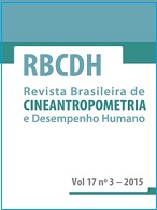Muscle quality, but not muscle thickness, is decreased in different age groups of active older women
DOI:
https://doi.org/10.1590/1980-0037.2015v17n3p347Resumen
The aim of this study was to compare the muscle thickness (MT), muscle quality (MQ), and functionality of two different age groups of active elderly women. Twenty seven older women (between 60 and 80 years old), physically active was dividing in two age groups: old 60-66 years (Old) and old 73-80 years (Older) volunteered for the present study. Knee extension isometric peak torque (PT) was obtained during a muscle isometric voluntary contraction (MIVC), and the value was normalized by MT. The Quadriceps Echo Intensity (QEI) was defined as the mean Echo Intensity (EI) value founded in all quadriceps muscle portions in ultrasound imaging. Was found MIVC increased (p=0.024) in the O1 (120.26±24.77 N/m) group when compared with the O2 (99.25±20.95 N/m) group, but when the MIVC was normalized the difference did not exist between groups (p?0.05). The QEI was found increased in the Older group (97.10±17.35 a.u.) when compared with the Old group (80.18±14.95 a.u.) (p<0.05). Contrary to that, the QMT did not differ significantly between the groups (p?0.05). The Old group presented a significant higher number of repetitions in the 30SS (14.13±2.29 repetitions) when compared to Older group (11.25±1.95 repetitions) (p<0.05). We observed that even without significantly greater muscle size, the Old group presented the results of 30SS significantly greater when compared with the older group. Besides that, the QEI was found increased in the older group and suggests that EI may be the best predictor of functional capacity than muscle quantity in active older woman.
Descargas
Publicado
Número
Sección
Licencia

Direitos Autorais para artigos publicados nesta revista são do autor, com direitos de primeira publicação para a revista. Em virtude da aparecerem nesta revista de acesso público, os artigos são de uso gratuito, com atribuições próprias, em aplicações educacionais e não-comerciais, desde que seja dada a atribuição. Esta obra foi licenciada com uma Licença Creative Commons Atribuição 4.0 Internacional - CC BY


